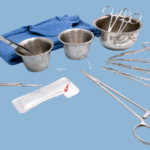Choosing Between CCCR Schedule 1 and Official Method DO-30: A Guide for Household Aerosol Products
When it comes to classifying and labeling household chemical products in Canada, manufacturers must adhere to strict regulations to ensure the safety of consumers. Aerosol products are classified as dangerous goods for transport and must be tested in their actual container or spray dispenser to ensure regulatory compliance.
Two key methods used for testing the flammability of products are the CCCR (Consumer Chemicals and Containers Regulations, 2001) Schedule 1 method and the Official Method DO-30. Understanding the differences between these two methods and knowing when to use each is essential for compliance and accurate hazard communication.
Understanding the CCCR Schedule 1 Method
The CCCR Schedule 1 method is specifically designed for assessing the flammability of aerosol consumer chemical products under the Consumer Chemicals and Containers Regulations, 2001 (CCCR). It applies to products that fall under the jurisdiction of Health Canada and are intended for consumer use. The test evaluates a product’s Flame projection and flashback. The flammability requirements set by Canadian legislation are covered by these regulations, ensuring that all relevant safety aspects are addressed.
The classification of a product as “Flammable” or “Very Flammable” is determined by the results of the flammability tests according to CCCR criteria. The results directly influence labeling requirements, including hazard symbols, risk phrases, and precautionary measures that must appear on product packaging.
The manufacturing, importation, advertising or sale of a flammable product that is classified in the sub-category “very flammable” is prohibited unless the product classification is due to flashback test results and not a flame that projects greater than 100 cm.
The Hazard Symbols and language required by CCCR to appear on a product classified as “Very Flammable” and “Flammable is as follows:
Type of information | English | French |
Very Flammable | ||
Hazard symbol |
| |
Signal word | EXTREME DANGER | DANGER EXTRÊME |
Primary hazard statement | VERY FLAMMABLE | TRÈS INFLAMMABLE |
Flammable | ||
Hazard symbol |
| |
Signal word | DANGER | DANGER |
Primary hazard statement | FLAMMABLE | INFLAMMABLE |
Understanding Official Method DO-30
Official Method DO-30, on the other hand, is used for classifying flammable consumer aerosol products under the Food and Drug Act, Food and Drug Regulations (FDR), and Cosmetics Regulations (CR). Products categorized under these regulations are exempt from CCCR 2001.
Official Method DO-30 provides a standardized approach for assessing the flammability of aerosols by measuring their flame projection and flashback, with flashback testing being a critical part of the assessment. The results dictate how these products should be classified, labeled and handled by both consumers and in occupational settings. The FDR and Cosmetic Regulations do not have a provision to ban Extremely Flammable products.
The Hazard Symbols and language required under the FDR to appear on the product classified as “Flammable” and “Extremely Flammable are as follows:
Ignition Source and Safety Considerations
Different aerosol flammability test methods use varying ignition sources. The most common sources include candle flame, propane burner, and Bunsen burners. The ignition source can significantly influence the flammability results.
For example, the candle flame used in 16CFR1500.45 (Method for determining extremely flammable and flammable contents of self-pressurized containers under the US Federal Hazardous Substances Act) is set at a specific temperature and positioned at a fixed distance from the aerosol actuator. In contrast, the CCCR Schedule 1 method utilizes a propane burner candle at a set distance, while the UN TDG Ignition Distance Test employs a Bunsen burner that is moved incrementally to measure ignition distance. These differences in ignition source and positioning can affect whether ignition occurs, the length of flame projection, and the overall flammability classification of the aerosol product.
The position of the aerosol can during testing is equally important. Some test methods require the can to be upright, while others may specify an inverted position, depending on the intended use of the aerosol spray. Following the correct test method and positioning ensures that the flammability test accurately reflects real-world usage and meets regulatory requirements.
Outside of the CCCR Schedule 1 and DO-30 test scope, other aerosol flammability tests include:
- The enclosed space ignition test (or closed drum test) measures the ignition distance and evaluates how easily an aerosol can ignite in a confined space.
- The flame projection test determines the length and direction of the flame when the aerosol is sprayed through a candle flame, providing insight into potential hazards.
- The aerosol foam flammability test assesses the flammability of foams produced by aerosol dispensers, which is crucial for products like shaving creams and hair mousses.
By carefully considering the ignition source, test method, and safety protocols, manufacturers can ensure their aerosol products are tested accurately, classified correctly, and labeled in accordance with Canadian regulations. Prioritizing safety and compliance not only protect consumers but also helps manufacturers avoid costly recalls and regulatory penalties.
Key Differences Between CCCR Schedule 1 and DO-30
Feature | CCCR Schedule 1 | Official Method DO-30 |
Regulatory Framework | CCCR, 2001 (Consumer Products) | Food and Drug Regulation, Cosmetics Regulation |
Application | Aerosol consumer chemical products | Cosmetics, Drugs and Disinfectants in metal pressurized containers |
Labeling Requirements | CCCR labeling (hazard symbols, risk phrases) | Food and Drug Regulation, Cosmetics Regulation |
Manufacturing, importation, advertising or sale ban | Aerosol product with a flame projection equal to or greater than 100 cm | No ban |
Intended Audience | General consumers | Food, Cosmetic, Drug and NHP consumers and professionals |
How to Choose the Right Method
Selecting the appropriate method depends on the intended use and regulatory requirements of the product:
- General Use Consumer Products (e.g., household cleaners, air fresheners, spray paints, adhesives, lubricants): Use the CCCR Schedule 1 method to determine flammability and ensure compliance with Health Canada’s consumer product regulations.
- Cosmetics, Food, Drugs, and NHP products (e.g., hair spray, sunscreens, deodorants, disinfectants): Use the Official Method DO-30 method to determine flammability and ensure compliance with Health Canada’s Food and Drug Act requirements.
📞 Need Help Choosing the Right Test?
At Dell Tech Laboratories, we specialize in helping manufacturers classify and label their aerosol products accurately. Whether you’re exporting to Canada or manufacturing locally, we can ensure your compliance with testing requirements, enhance safety, and prevent misclassification of products.
Contact our regulatory experts today to determine which flammability testing method is right for your product.
DELL TECH HAS PROVIDED PROFESSIONAL, CONFIDENTIAL CONSULTING SERVICES TO THE SPECIALTY CHEMICAL INDUSTRY IN CANADA, THE USA, EUROPE AND ASIA FOR THE LAST 40 YEARS.





